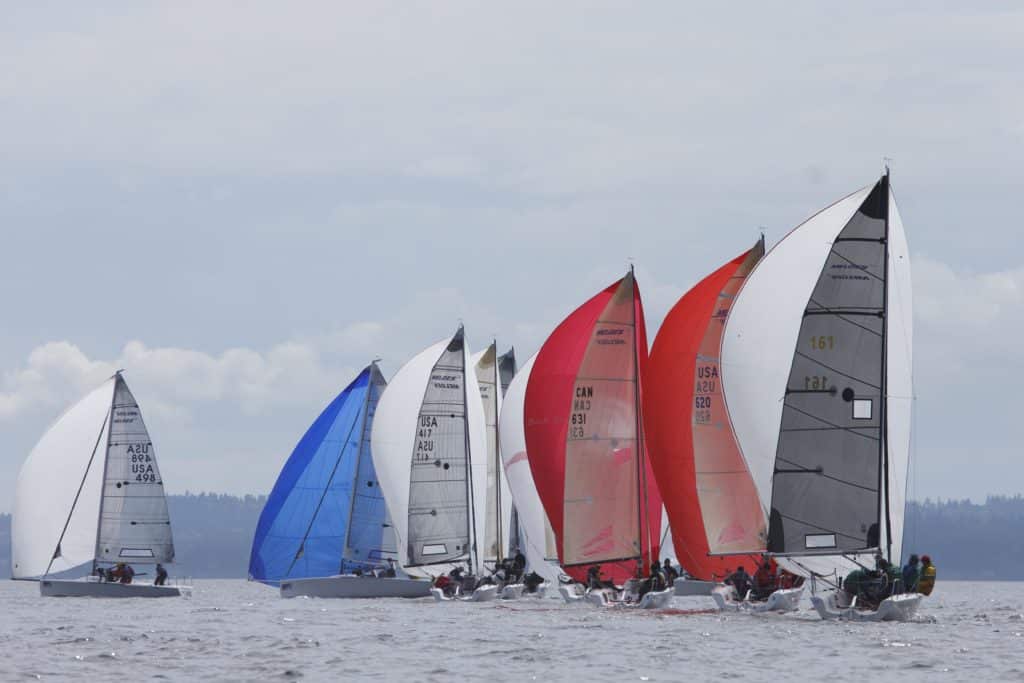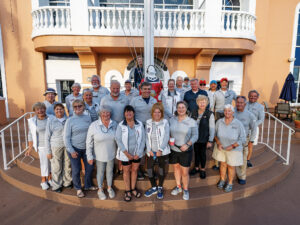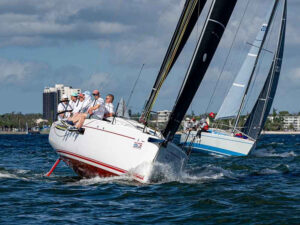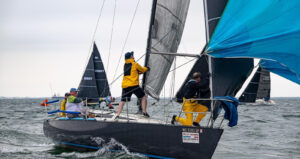If it’s a southerly wind direction, especially a southeasterly, then protect the shore side because of puffs coming off the shore are lifts on port tack. When there’s a puff, it funnels through the area where the locks are: every boat that’s closer to shore gets the puffs sooner and longer.
Seattle offers some of the finest racing in the country thanks to the Olympic Mountains to the west and the Cascade Mountains to the east, which funnel weather systems into flowing primarily from the north or south. The northerly winds are “fair weather” winds during May and June. When high pressure moves over Washington and the barometer climbs, the northerlies begin a three- to four-day cycle.
The first day will see the northerly develop later in the day, and it will typically top out at 10 to 13 knots. The second day is usually the strongest day of the cycle, with winds building from 1 p.m. to 2 p.m., until shutting off after dark at 9 p.m. This breeze will get additional boost, if there’s been early morning clouds that burn off quickly. The continuous heating of downtown Seattle will add 2 to 4 knots of sea breeze effect to the northerly. The sea breeze thermal boost is due to the cold Puget Sound temperature. The sound is 48 to 52 degrees year-round, so plan your sailing gear accordingly. On the third and fourth days, the pattern of Day 2 of the northerly cycle will return, but expect a decreasing top wind speed.
Southerly and southwesterly winds have the potential to be much stronger. Winds from these directions are caused by low-pressure systems moving onshore. These winds will typically flow with a more southeasterly direction at the beginning of the front, and move to southerly and then southwesterly as the low-pressure ridge passes between Shilshole and the Cascades. Winds will blow 12 to 25 knots in May from any part of the southerly direction.
The rare westerly is a strong frontal passage in which you won’t see high winds due to the mountains to the west, but you will see this direction as the breeze transitions from the southerly to the northerly. “Trust it least” is what we say about the easterly. With water depth at 150 to 650 feet deep in the course area, the committee should not be in a hurry to set marks in the easterly or westerly because it will only delay getting the course set in a reliable wind from the north or south.
Up to 1.25 knots of current flows from north to south as the tide floods into Puget Sound. If you’re racing in northerlies, the current will make the beats longer and runs shorter, putting a premium on getting and holding a lane and good tacking. As the tide changes to an ebb tide, an eddy will eventually form north of and off of Meadow Point, which can cause “elevators” of currents breaking off the eddy and onto the course area. Keep your eyes peeled for changes in the water surface.
Since we’re not racing in mid-June, which has the highest tide changes of the year, the current won’t heavily influence tactics, especially if the winds are stronger. In terms of geographic advantages, for racecourses north of Meadow Point, the curve of the shoreline creates a lift on starboard tack in a northerly at the top of the starboard tack layline. In a southerly, it’s a much more even course, unless the current is running hard, at which point the shoreline will provide current relieve. If you’re sailing upwind in unfavorable current, take your layline carefully so you don’t spend a lot of time short tacking to lay the mark.
In a southerly or southeasterly, the weather mark might end up positioned just north of Meadow Point, behind a high bluff, which create a bit of wind hole, so it’s better to approach from 90 degrees to the shore and avoid the light air that develops on the port-tack layline.
The dinghy courses will be set closer to Shilshole Marina, about a half-mile from the breakwater. Here, there are a few other geographic considerations. On the south side of the Marina, for example, is where the spill out from the locks flows. Because of record rainfall in March, there will be likely a lot of freshwater outflow, so look for extra current push along the shore. If the tide is ebbing, there’s going to be to increase flow, and conversely, it will minimize the flood in that area because that current is flowing at a northwesterly angle. Current lines are plenty visible on the water. If the wind is in a north-northeasterly direction, the shore side of the course will be favored because of the wind curving around Meadow Point. When tacking into the shore for current relief, expect a header in, and lift on the way out. One word of caution, however, it’s best not to take tack deep into shore between the north end of breakwater and the beach concession building because the bluff and high trees northeast of that block the wind.
If it’s a southerly wind direction, especially a southeasterly, then protect the shore side because of puffs coming off the shore are lifts on port tack. When there’s a puff, it funnels through the area where the locks are: every boat that’s closer to shore gets the puffs sooner and longer.
If a new southerly front is approaching it, it’s usually coming from the southwest and will bring a stronger pre-frontal breeze that will overpower the shore/geographic advantage. In this case, look for the pre-frontal breeze to be stronger offshore.










